Groundhog Day at New Zealand's worst intersection
- Grant McLachlan
- Dec 12, 2024
- 11 min read
Updated: Jan 18

New Zealand's worst intersection symbolises decades of vested interests and dirty politics dividing an increasingly irrelevant community.
Warkworth's Hill Street intersection is the gift that keeps on giving for the news media. It's like the clock stops, resets, and the same stories repeat in 5-10 year cycles. It's been a problem for over 40 years but every time the intersection is close to being fixed, a National government pulls the plug.
Today, Stuff's Caroline Williams ran this article about dashcam footage of a Warkworth Police patrol vehicle entering the intersection at speed and expecting another vehicle already on the intersection to give way to them. Here's the footage:
The driver was issued with a fine by a police officer returning to the Warkworth Police Station after patrolling the new motorway. Apparently, the police officer just happened to be the same officer who allowed vigilantes to run a Snells Beach police station unsupervised.
In the article, road safety campaigner Clive Matthew-Wilson was critical of both the police officer and Toms:
"The police car appeared to be moving at above average speed. The cop either didn’t appear to notice Toms, or didn’t allow for the fact that he was in his path. If I had to make a call, I would say that both drivers were at fault, but the police car set a very poor example of road awareness. If that cop car had been going a bit slower, or had had its flashing lights on, then this near-accident would never have occurred.”
A police spokesperson, however, said the officer was not in the wrong.
“In this particular instance, the motorist should have given way to their right as per the road rules, and that is why police issued an infringement offence notice. Drivers are welcome to dispute infringements by writing to the Police Infringement Bureau.”
The dashcam footage, however, was a timely reminder of the many problems with the intersection. The overarching issue, Matthew-Wilson said, was:
"The absurd complexity and poor design of the intersection. A good intersection makes it easy to do the right thing and hard to do the wrong thing.”
The article was about how tricky the intersection was to navigate for some people and how a shelved upgrade would avoid confusion. In the comments section and throughout several local Facebook groups, however, many residents missed the point. They preferred to point out how well they knew the road code. Many wrote about their knowledge, experience, and explained how to navigate the intersection. Some even seemed to try to gain brownie points with the local police, which is hardly surprising. Some even said that they didn't have an issue with the intersection.
All these comments provided excuses for roading authorities to do nothing. And they have done nothing.
The problem with the intersection
I was involved with a campaign to fix the intersection. I went through the history to understand the problem, modelled and simulated various design options, and put together communications and political strategies to achieve momentum. The logo I designed was based on the shape of the intersection and its resemblance to a dog:

The turn in the dashcam footage is this one:

If you look at the NZTA website, it is not clear who gives way to whom.
It would help to understand a bit of history of why the intersection is configured that way.
The purpose of the give way on Sandspit Road is:
to prevent the blocking of the Elizabeth Street intersection; and
to prevent traffic from the old State Highway 1 being held up by the Elizabeth Street intersection being block.
I think that the give way on Sandspit Road is unnecessary now as there is road marking to warn traffic from blocking the intersection, there is a separate lane for the sliplane, and there are traffic light sequences preventing such conflicts in flows.
Also, the give way is unnecessarily confusing as it is not immediately apparent who must give way to whom. One needs to look around and see the shape of signs or guess the colour of a traffic light at four connecting roads.
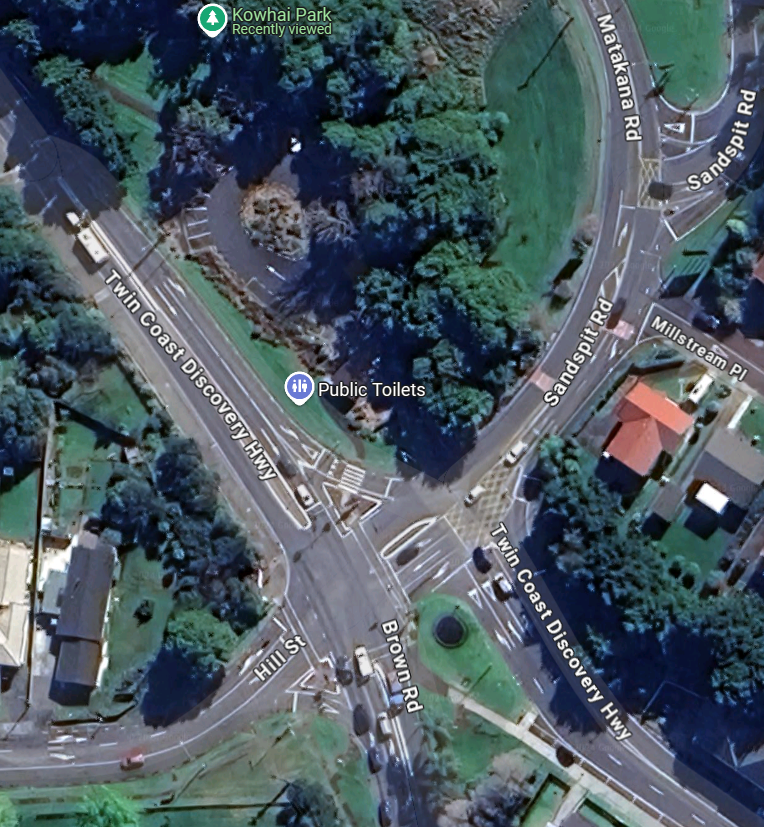
The Kowhai Park entrance is controlled by a stop sign, the sliplane off the old state highway is a give way before a raised pedestrian crossing, and there are separate traffic lights for the old state highway and Hill Street.
The decision to cancel the upgrade of the intersection was made in February 2024, following the scrapping of the regional fuel tax. There simply wasn't any money left from the regional fuel tax for the upgrade. So, why is there suddenly media interest in the past fortnight?
Where did the money go?
The regional fuel tax, however, funded the Matakana Link Road, which was given priority over the Hill Street intersection upgrade, despite the business case forecasting that the link road would divert only 4% of the traffic away from the Hill Street intersection. Despite an unfavourable benefit to cost ratio, the link road was built to four lanes.
The road wasn't just a bypass. Instead of being an 80km/h stretch like Matakana Road at one end or 60km/h like the old state highway at the other, the Matakana Link Road became a 50km/h four lane arterial with two added intersections along its 1200m length. The two added intersections provided access to commercial and residential developments with over 1200 lots. The cost of the link road per metre was in the same price range as the Puhoi to Warkworth section of the Northern Motorway completed at the same time.

Usually, if a development generates more than 90% of the traffic on a road through it, the developer would pay for the road. Instead, the government and council paid $63m for it, including buying land off the developer.
For the Puhoi to Warkworth motorway, the Crown purchased 1,294 hectares at a total cost of $122.3 million, including $23.5 million for costs of the process. That equates to $94,513 per hectare. For the Matakana Link Road, I pieced together the following table:
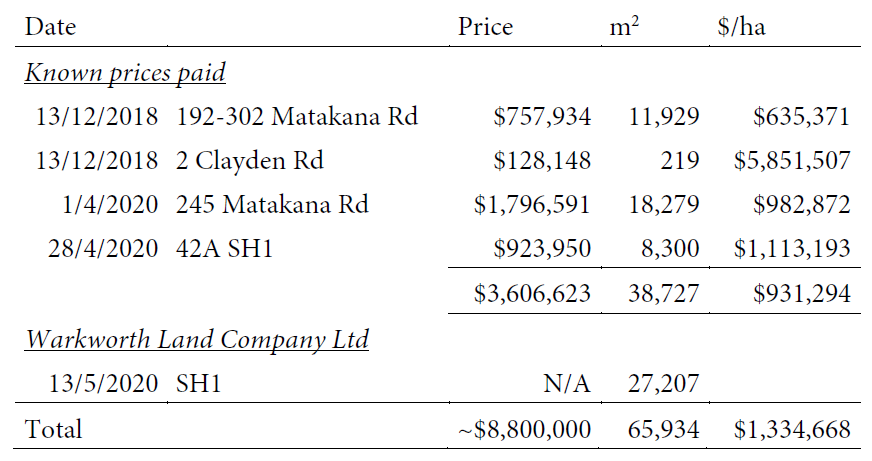
It wasn’t difficult to estimate the missing figure.
Effectively, Auckland motorists paid 10 cents extra a litre for petrol to fund a road that developers should have built.
Bayleys Real Estate director Mark Macky and local MP Mark Mitchell were involved with every stage of the negotiations. Mark Macky got a commission on sales, the listings for the developments, and local company aligned to the developers, Wharehine, got the contract to build the road. Mark Mitchell even 'mediated' to prevent things going to court.
Bayleys employed National Party fundraiser Paul Bennett as their strategic advisor, attracting 53% of donations from property-related interests. Bayleys then donated $164,000 directly to the National Party.
Mark Macky was also chair of the One Warkworth business association. When Auckland Transport proposed reducing the Matakana Link Road to two lanes, he steered a public meeting, never declaring his conflicts of interest:

Mark Macky didn't want anyone to find out what he was up to. In one email, he invited a senior Auckland Transport official for drinks to meet his clients to "rather focus on positive things" that would benefit them:

Days after Fix Hill Street Now presented a 9000+ signature petition to local MP Mark Mitchell, Mark Macky was sneaking behind the backs of the Fix Hill Street Now campaign to prioritise the Matakana Link Road ahead of the Hill Street intersection:

These are just two examples of the backstabbing that went on. Fix Hill Street Now went from being at the forefront of the issue to being excluded, even being treated like persona non grata by the local community media.
While all of this was going on, the Serious Fraud Office was pre-occupied with the investigation of corruption at Auckland Transport. Described as the biggest corruption case in New Zealand's history, the Serious Fraud Office didn't have the resources to investigate further corruption at the organisation, stating:
"We need to put the misconduct before the courts, and that often doesn’t require prosecuting every last offence. In this case there were obviously a lot of people who received something but weren’t charged - you have to decide how much of the court’s time to take up."
In November 2023, Mark Mitchell became the Minister in charge of the Serious Fraud Office. Despite Judith Collins in 2020 promising to double the budget of the Serious Fraud Office so to focus on corruption, the budget in 2024 remained at $16m.
Mark Macky wasn't acting alone. A former Wharehine director provided a diversion of a different kind.
'Quick Fix'
While money was being diverted from fixing the Hill Street intersection, there were other attempts to divert Auckland Transport's attention.
While the Fix Hill Street Now was gaining traction (and national media attention), the Snells Beach Ratepayers' and Residents Association (SBRRA) gave Auckland Transport an excuse to do as little as possible. Rodney Local Board Member Greg Sayers moved to Snells Beach and dossed next to two SBRRA committee members: Diane Taylor and Mark Dinniss. For Sayers, he used it as his base to campaign against Penny Webster - a race for the councillor position that he eventually won.
Another committee member was former Wharehine director Maurice Hooper. His neighbours included the SBRRA secretary Eileen O'Loan, Neighbourhood Support coordinator (and community Facebook group administrator) Jenny Bartlett, and Warkworth Police Sergeant Mark Stallworthy. After Fix Hill Street Now's billboards appeared throughout the area, this appeared on the SBRRA website, which I have highlighted in blue:
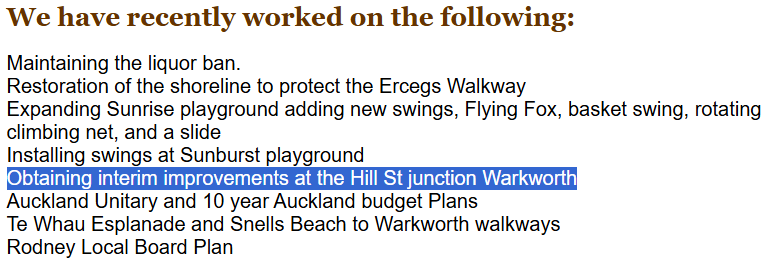
Maurice Hooper convinced Auckland Transport to erect a few plastic bollards restricting access to Elizabeth Street from traffic turning right into it:

This would mean that only traffic along Sandspit Road from the directions of Snells Beach and Matakana could access the high street into Warkworth. Traffic from Hill Street and the old state highway would have to enter Warkworth's CBD from Whitaker Road 600m to the south. Here is a diagram:

In other words, it would restrict the police car in the dashcam footage and require him to do a 1500m detour to the police station.
Elizabeth Street retailers protested:

The three month trial was cancelled after one month.
So, it was back to the drawing board.
Eventually, in November 2023 this was the design chosen:
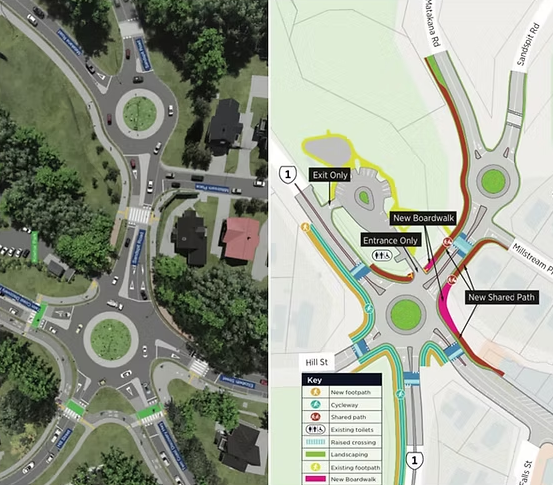
After millions of dollars spent on that design, it was very similar to my design, which appeared in the The Herald on 19 May 2016:

All that effort and the project was back to square one.
Some interests wanted Fix Hill Street Now forgotten. Some even claimed to not know me.
"An unknown man"
What started as a few columns in The Herald became a full campaign. I appeared on the front page of the local community paper several times:

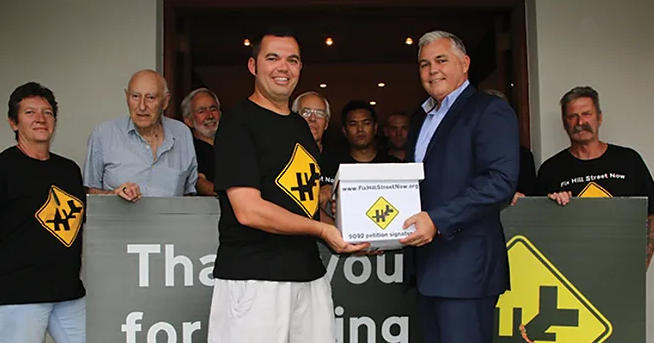
I also appeared in news items on TV, radio, and print. A TV show was even produced. It was a high profile campaign.
Just between the intersection and Point Wells, there were five billboards against the Elizabeth Street trial, including this one:

In the next issue of Mahurangi Matters after the Elizabeth Street protests issue, four letters to the editor about the trial featured first. None were opposed to the trial. The first two letters were from SBRRA committee members. The third was was from a Sandspit resident, environmental engineer, and vigilante who slashed the tyres of eight boat trailers parked near a shorebird sanctuary. The fourth letter was from a Point Wells resident, Lorraine Martin:

So, we had letters from the person behind the trial, a SBRRA committee member, and residents from Sandspit and Point Wells that gave the impression of support from across the community.
But the trial only benefited communities east of the intersection. In the following issue, there were several letters on the same topic, but listed last:

My letter sought a solution to the intersection that didn't divide the community, benefiting everyone without leaving anyone worse off. Other letters criticised the letters from Maurice Hooper, Diane Taylor, and Lorraine Martin for acting in their self interest.
According to Lorraine Martin, she has been friends with Diane Taylor since before she moved from Raumati Beach to Point Wells in January 2011. Lorraine then moved to Snells Beach in February 2019. On 4 May 2021 and 17 September 2021, I published an article revealing the SBRRA's dirty politics, mentioning Diane Taylor. On 18 September 2021, Lorraine Martin visited Diane Taylor, then followed me, attacked me, threw her "expensive" camera at me, fled the scene, returned to Diane Taylor's home, rang 111, and claimed that I attacked and robbed her. In her police statement, she described me:

I had caught Lorraine Martin unleashing my dog and trying to take a photo. Lorraine Martin, however, then said this:

The 'independent' witness was none other than another SBRRA committee member, Paul Shanahan. Paul Shanahan claimed to have seen me attack Lorraine Martin twice within metres of him over the period of three minutes and never intervened, only approaching her after I left the scene. He then convinced others to align their position with his.
Throughout the 111 call that Lorraine Martin made from Diane Taylor's home phone, Diane Taylor could be heard in the background telling her what to say. When Lorraine Martin mentioned where she was, Diane Taylor interrupted, telling Lorraine Martin that I was wearing a grey jacket with black hoodie. Despite Lorraine Martin saying in her police statement that she didn't know who I was, she mentioned me by my full name four times in her 111 call, even saying that I lived in Snells Beach and was "a real trouble maker."
In other words, Lorraine Martin knew who I was and lied about it in a sworn police statement. Any mention of Diane Taylor was redacted from all documents.
A week prior, my dog was unleashed from the same fence and SBRRA founder (and former Rodney Local Board member) June Turner was at the right place at the right time, took a photo, lodged it with the council, and I received a council fine - which was later waived.
I was charged with assault and robbery, facing 10 years in prison. Right up to the trial, the prosecution's case was based on Lorraine Martin's belief that I had only taken one photo of her. I had, however, taken four, clearly showing that Lorraine Martin had charged towards me and attacked me with the sharpest corner of her camera:
Caught in a lie while under cross examination from my lawyer, she tried to pervert the course of justice several times. First, she tried to hand a note to the Crown Prosecutor with suggested questions for re-examination that others had helped her prepare. Then, her support person, Lois McPherson, even whispered through her mask "You don't know anything about that" when Lorrraine was asked about Diane Taylor's role in a SBRRA committee plot to defraud $6000 from Auckland Council in a 16 September 2021 application for funding. I was offered a mistrial twice but I wanted a verdict.
Photographic evidence was shown to the court of Lois McPherson implicated in a third attempt to unleash my dog. A dog ranger led Lorraine Martin to believe that if my dog was caught off leash three times, it would be destroyed.
Throughout the trial, Lorraine Martin changed her story about visiting Diane Taylor prior to her attacking me. She also inadvertently revealed how well she actually knew me and Paul Shanahan.
I was acquitted.
It was obvious that Lorraine Martin hadn't acted alone. The SBRRA Committee repeatedly relied on Lorraine Martin to do their dirty work.
Lorraine Martin's confidence to act in the way that she did was reinforced by her connections with SBRRA committee members who were neighbours with politicians and police. Besides, she was also the mother of a senior police manager. She was the right person for the political hitjob.
If this was how vested interests in Snells Beach behaved, how were they treated by politicians?
Stockholm Syndrome
Rodney is a National Party stronghold. In the front rows of this election rally, June Turner and Maurice Hooper cheered Chris Luxon and Chris Penk on (circled in red):

National can ignore the safe electorate. And it does. The last time that a planned upgrade of Hill Street was canned, National was in power.
The local MP, Chris Penk, became Building Minister in November 2023. Shortly after, large-scale subdivisions south of Warkworth were fast-tracked - without a connection to the motorway. In all the recent articles about the scrapping of the upgrade, One Warkworth cronies Murray Chapman and Dave Stott repeat a common theme: upgrading the intersection is necessary for future growth.
I can understand why the Hill Street intersection has been shelved. It has been sobotaged by so many vested interests, it has divided the community, creating more excuses for roading authorities to do nothing. Meanwhile, developers continue to lobby for new roads, such as the Sandspit Link Road, Western Connector, and even new motorway interchanges. This will create a ring road and a new CBD - much like Albany - and leave the residents of central Warkworth and Snells Beach in gridlock.
Meanwhile, locals keep supporting politicians who keep them captive, like Stockholm Syndrome.
I tried to unify a community towards a goal that would benefit everyone. Instead, I was undermined, backstabbed, stigmatised as a troublemaker, and there were nine failed attempts to stitch me up.
Hill Street isn't my problem anymore. I could tell the local rackets to go to hell, but they're already there.

These are just some examples of the many dodgy stunts involving vested interest in my book Unleashed: Sex, rackets & vigilantes in New Zealand's most corrupted community.








